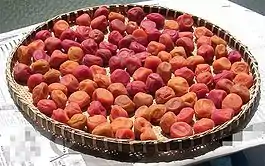Umeboshi
Umeboshi (Japanese: 梅干, pronounced [ɯmeboɕi], literally 'dried ume') are pickled (brined) ume fruits common in Japan. The word umeboshi is often translated into English as 'salted Japanese plums', 'Japanese plums' or 'preserved plums'. Ume (Prunus mume) is a species of fruit-bearing tree in the genus Prunus, which is often called a "plum", but is actually more closely related to the apricot.[1] Pickled ume which are not dried are called umezuke (梅漬け).


Umeboshi are a popular kind of Japanese tsukemono ('pickled thing'; preserved or fermented) and are extremely sour and salty. Sweet umeboshi made with honey also exist. They are usually served as a side dish for rice or eaten on rice balls (often without removing the pit) for breakfast and lunch. They are occasionally served boiled or seasoned for dinner.[2]
Physical characteristics
Umeboshi are usually round and vary from smooth to very wrinkled. Usually they taste salty, and are extremely sour due to high citric acid[3] content, but sweeter versions exist as well.[4]
The central area of Wakayama prefecture is known throughout Japan for the number and quality of its ume and umeboshi. The town of Minabe, Wakayama, in particular, grows more ume and produces more umeboshi than any other town in Japan.[4]
Production


Umeboshi are traditionally made by harvesting ume fruit when they ripen around June and packing them in barrels with 20% salt per weight of fruit. The salt extracts juice, which the ume then soak in for about two weeks. This salty, sour liquid is marketed as umezu (梅酢; often translated as 'ume vinegar', although it is not a true vinegar.)[5]
Many varieties of umeboshi sold on the market are desalinated to a certain extent and re-soaked in a flavoring liquid. They are sometimes dyed red using purple perilla herbs (called akajiso) or flavoured with katsuobushi, kombu or even sweetened with honey. Because these flavored varieties end up at 3% to 15% salt content, they usually contain a natural or artificial preservative to extend shelf life. Natural preservatives include vinegar, alcohol and vitamin B1.
Consumption
Umeboshi are usually eaten in small quantities with rice, for added flavor. It is also a common ingredient in onigiri, rice balls wrapped with nori and they may also be used in makizushi. Makizushi made with umeboshi may be made with either pitted umeboshi or umeboshi paste (which is cheaper), often in conjunction with slivered fresh green perilla (shiso) leaves. The standard Japanese folk remedy for colds and flus is okayu (rice congee) with umeboshi. Another usage of umeboshi is in "Ume chazuke", a dish of rice with poured in green tea topped with umeboshi.
Umeboshi were esteemed by the samurai to combat battle fatigue, a function of their salt and citric acid content, among other factors. Salt, citric acid, and polyphenols also contribute to their antimicrobial activity, so they are a natural preservative for foods and help prevent food poisoning and other bacterial stomach problems.
Umeboshi is used as a cooking accent to enhance flavor and presentation. They may also be served as a complement of a drink with shochu and hot water.
Umeboshi are often eaten as snacks; in the United States and Australia, many Japanese grocery stores stock them. Eating umeboshi in Japan is the equivalent of the English expression "an apple a day".[6] Children's candy shops sometimes carry karikari ume, or prepackaged, crunchy pickled ume, and dried umeboshi.
Health
This Japanese style traditional condiment is believed to be a digestive aid, prevention of nausea, and for systemic toxicity, including hangovers. Green ume extract is used as a tonic in Japan. The citric acid is believed to act as an antibacterial, help to increase saliva production and assist in the digestion of rice. Additionally, umeboshi is claimed to combat fatigue (historically given as part of a samurai's field ration) and protect against aging.[7]
Nutrition
Pitted traditional umeboshi per 100 g contains:[8]
- Calories 33 kcal
- Protein 0.9 g
- Fat 0.2 g
- Carbohydrate 10.5 g
- Sodium 8700 mg (equivalent to 22.1g of salt)
- Potassium 440 mg
- Manganese 0.23 mg
- VitaminA 7 μg
- VitaminB1 0.02 mg
- VitaminB2 0.01 mg
- Cholesterol 0 mg
- Dietary fiber 3.6 g
- Water 65.1 g
Traditional (non-reduced sodium versions) umeboshi are roughly one quarter salt.
Similar foods
The umeboshi style of pickling is common in Japan and is similar in style to other Asian preserved pickling techniques found in China, Vietnam, and Korea.[9]
In Vietnam, a very similar variety of pickled ume is called xí muội or ô mai.
In South Asian countries, Indian gooseberries called amla in Hindi or Amala in Nepali is prepared in similar way, sometimes with sugar syrup.
In Mexico, it is known as chamoy and is usually made with apricot, ume or tamarind and a mix of salt and dry chili.
In South Africa, a similar style of preserved dried fruit is called mebos in Afrikaans, the name of which seems to derive from the Japanese via Dutch trade. Usually, apricot is used to produce a salty, acidic variety, although other, sweetened varieties made from other fruits are also colloquially called mebos.
See also
- Li hing mui
- List of pickled foods – List of links to Wikipedia articles on pickled foods
- List of plum dishes – Wikipedia list article
- List of sauces – Wikipedia list article
- Pickled fruit – Fruit that has been preserved by anaerobic fermentation in brine or immersion in vinegar
- Suanmeitang
- Smoked plum
- Wikibooks:Cookbook:Umeboshi
References
- Tsuji, S. (2007). Japanese Cooking: A Simple Art. Cookery, Food and Drink Series. Kodansha International Limited. p. 317. ISBN 978-4-7700-3049-8.
- Umeboshi: perfect in any culinary pickle | The Japan Times
- Nakatafoods: Umeboshi
- Itoh, Makiko, "Umeboshi: perfect in any culinary pickle", Japan Times, 25 May 2012, p. 18
- Mary Choate and Aaron Brachfeld (31 August 2015). At Home in Nature, a user's guide. Coastalfields Press. p. 303. GGKEY:K5213DDZJD2. Retrieved 21 January 2013.
- "Umeboshi: World's Strangest Hangover Cures." Travel and Leisure. Retrieved on March 8, 2009.
- "HEALTH BENEFITS OF UMEBOSHI : MAKING TRADITIONAL UMEBOSHI : UMEBOSHI - Venerable Pickled Plums : MITOKU COMPANY, LTD. - Organic Japanese Foods Exporter". Mitoku.com. Retrieved 2012-11-19.
- "Standards Tables of Food Composition in Japan -2015- (Seventh Revised Edition) Documentation and Table". Ministry of Education, Culture, Sports, Science and Technology (MEXT), Japan. 2015. Retrieved 2020-09-17. (English version of the ja:日本食品標準成分表). 2.Table (Excel:890KB)
- Item No.=07022 "Umeboshi" (pickled and dried mume), salted pickles (traditional salty recipe)
- Item No.=07023 "Umeboshi" (pickled and dried mume), seasoned pickles (reduced-salt version)
- The 150 healthiest foods on earth. By Johnny Bowden
External links
| Wikimedia Commons has media related to Umeboshi. |
